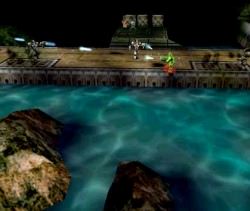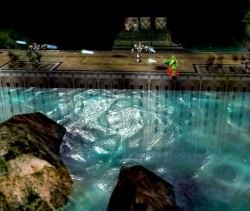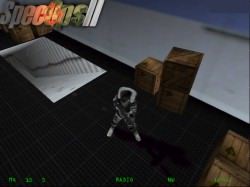| Matrox G400 MAX
by Leonard "Viking1" Hjalmarson |
||||
|
Vibrant Color Quality2 is the term that Matrox has trademarked for their color rendering technique. In order to achieve maximum precision in rendering color, all images are rendered using a true color palette and full 32-bit precision in the internal pipelines of the video card. If the resulting image to be displayed is 32-bit, it will be very accurate across color gradients. But if the resulting image must be 16-bit, then all the internal calculations occur in 32-bits and are finally dithered to 16-bit from a true color palette. This eliminates much of the streaking, banding and other artifacts that are commonly produced by this process. The proof is in the pudding, but there are two facts worth noting here. These new video boards take a much smaller hit when running full 32 bit color than the last generation. But if the artwork and textures for the game have been rendered in 16 bit color then you won't gain much by running in 32 bit mode. I checked with Wayward studios on their coming B17 II simulation, and they confirm that the artwork is being done in full 32 bit pallettes! The subjective test of VCQ2 comes in the form of comparing a Falcon4 mission on Voodoo3 vs. Matrox G400 MAX. Could I see the difference? Yes, to my surprise, colors appeared richer at the same resolution and color depth in the same mission on the same monitor running the G400 MAX. The G400 chipset has hardware support for a form of texture control called Environment Mapped Bump Mapping. TNT2 and Voodoo3 support embossed bump mapping, which is not as accurate or as impressive as environment mapped bump mapping. Check out these two screen shots from Expendable to see the difference. The first shot is with embossing OFF, the second uses Matrox own hardware based method.
 Expendable with normal water
 Expendable: Matrox with EBM |
 Spec Ops II In order to achieve this effect the software must support the hardware feature directly. While Matrox has garnered some serious support, the sim developers are only beginning to take notice. This listing includes relevant developers:
AGP, SRA, NASA and CIA I promise to get serious now. The G400 MAX has full AGP support: 1x, 2x and 4x, including AGP texturing and sideband support. Matrox, however, rarely seems content to tow the line and have developed a technology called SRA, or Symmetric Rendering Architecture. SRA is an intelligent management system that masterminds allocation of local vs. non-local memory, deciding which textures are stored in local video memory and which are stored in system memory. Smaller textures that are used often are stored in local memory, where they can be called up faster. Larger textures are normally stored in AGP memory where a greater amount of memory is available. Most other AGP chips store copies of textures in AGP memory when texturing from local memory. The SRA allows the G400 to move the texture from system memory to local memory and then return it to system memory when it is no longer needed, or when more frequently used textures need to be swapped into local memory. In this way available memory resources are maximized, with the most efficient possible use of local (and therefore fastest) memory. 32 BPP Z Buffer and Stencil Buffer Just like the TNT2, the G400 supports 32 bit Z-Buffer with an 8-bit stencil buffer. Stencil buffering can be used to specify conditional masks, which in turn allows for dissolve and transition effects including such niceties as volumetric shadows, silhouettes, scorch marks and the like. For sim fans an even more common feature becomes useful. The cockpit in a flight simulator acts as a stencil and masks complex scenes so that only external scenery must be redrawn in a frame, contributing to an improved frame rate. The 32 bit Z-buffer is only now becoming a consideration for gamers, previously limited to CAD applications. A 32 bit Z buffer provides for depth precision and enhanced image quality. A classic example is a flickering shadow on an uneven floor. The flicker occurs when the Z value of the shadown changes relative to the Z value of the floor, resulting in the shadow disappearing at times. With a 32 bit Z-buffer, it is much less llikely that the Z value will change enough for the shadow to disappear. Go to Installation and Performance Tests
|
|||
|
Copyright © 1997 - 2000 COMBATSIM.COM, INC. All Rights Reserved. Last Updated August 14th, 1999 |
||||
